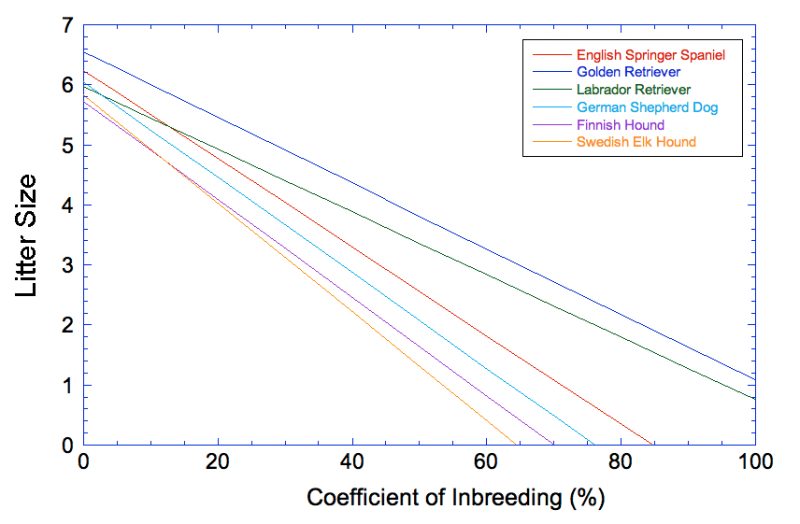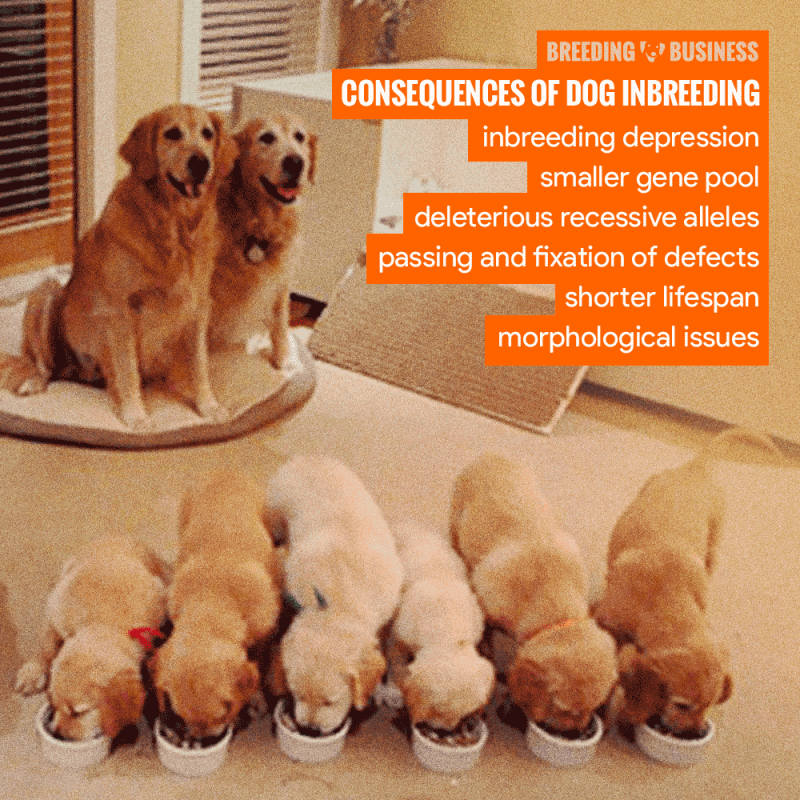Unfortunately, the question of whether you can breed a dog with its parent isn’t straightforward. If you want to be technical, then yes you can. The two dogs can mate and even conceive. Whether you should cross a mother dog with her
, this is a different question.
Dogs being bred father to daughter is a classic example of extremely close inbreeding. According to studies, breeding closely related dogs reduces the genetic diversity of the pure breed, which raises the prevalence of inherited and medical conditions.
In a nutshell, breeders should almost never ever attempt to mating a daughter with her father’s dog or any parent with any child. In addition to the unethical and immoral relationship, several generations’ health is in jeopardy. With such close linebreeding, the risks outweigh the potential benefits.
What happens if a mother and son dog mate?
Inbreeding is a type of breeding in which two dogs with similar DNA and close family ties are crossed. They could produce puppies with desirable physical traits if they inbred two related dogs, and perhaps no issues would arise.
Risks of Breeding Father to Daughter in Dogs
In general, due to the numerous risks involved, it is frequently strongly advised NOT to breed father and daughter dogs.
In fact, The Kennel Club has prohibited this kind of breeding. Although some breeders offer a general defense for mating father and daughter dogs, the results are frequently less than desirable. The risks of father-daughter intermarriage outweigh the advantages. Understanding what transpires during the act of inbreeding of such close proximity is necessary for a better understanding As previously mentioned, a father and daughter’s inbreeding coefficient is extremely close, increasing the likelihood that their subsequent offspring will experience negative outcomes. Before choosing to breed two canines who are closely related, one should weigh the risks.

Due to the lack of gene variation in inbred dogs, close inbreeding has resulted in cases of infertility in dogs. It has been reported that inbred males have lower fertility rates than purebreds, which makes it very challenging for breeders to continue the process. The females also experience more absorbed litters and a higher incidence of giving birth to sick whelps. Furthermore, inbred dogs have a higher mortality rate as well.
Many breeders attempt to improve the traits by mating closely related individuals, but they neglect to consider the serious impact this has on the available gene pool. During routine breeding, gene pools are widened, resulting in a variety of available traits in a species that promotes growth and variety along generational lines. Close inbreeding, however, prevents the gene pool from growing and keeps it extremely small. Small gene pools are more susceptible to genetic disorders.
While occasional mild aggression in dogs is common, closely bred dogs frequently exhibit abnormal behavioral symptoms. These dogs typically don’t show affection to other dogs, their own breeders, or their owners. Additionally, they frequently exhibit much greater fear in circumstances that do not affect purebred dogs. They exhibit higher levels of aggression and irritability, and they are more impulsive and anxious. Additionally, inbred pets tend to be less intelligent as well.
Inbreeding has a high rate of passing on abnormal or undesirous genes to the offspring. It is more likely to isolate a congenital defect than it is to isolate beneficial genes. This enables recessive alleles to be more prevalent in inbred specimens which can often lead to inbreeding depression and genetic diseases.
Because both the father and mother have a higher chance of carrying the same set of these genes than in a typical breeding situation, such alleles are more likely to manifest in close matings. Many conditions that affect the immune system, abnormal faces and bodies, eye diseases, and even cancer can manifest these defects. Because the pups had grown to have such large heads as a direct result of this type of close linebreeding, many of the dams had to have C-sections.

Breeders may believe they are in the clear early on only to discover their dog is seriously ill later on. This is one of the distressing aspects of some of these congenital defects because they frequently do not manifest until later.
Natural Occurrenceof Inbreeding
To say that inbreeding doesn’t happen naturally is not accurate. A wolf pack that is geographically or by other means separated from other wolf packs may become very inbred. As the majority of the offspring inherit these genes, the effect of any harmful genes becomes apparent in later generations. Even though they inhabit different regions, wolves have been found to share a lot of genetic similarities. Perhaps wolf populations have been drastically reduced in the past due to the destruction of their natural habitat, leading to a genetic bottleneck.
Because the wolf lacks genetic diversity, they are more prone to illness because they cannot fend off certain viruses. Due to small litter sizes and high mortality rates, extreme inbreeding has a negative impact on their ability to reproduce. By bringing wolves from other regions into the inbred wolf packs, some researchers hope to create a more diverse gene pool.
The giant panda is yet another animal affected by inbreeding. This has resulted in low panda fertility and high infant mortality rates, similar to what happened to the wolf. Panda populations become more separated from one another as a result of humans blocking the routes that pandas once used to move from one place to another. As a result, pandas breed less successfully and find partners with different genetic combinations.
Domestic cat breeds like the Manx, which evolved on an island so that the gene for taillessness became widespread despite the issues associated with it, were created as a result of natural isolation and inbreeding. With the exception of the occasional cat jumping ship on the Isle of Man, there was little outcrossing, and the result of inbreeding is reflected in smaller-than-average litter sizes, stillbirths, and spinal abnormalities that conscientious breeders have worked so hard to eradicate. Geneticists believe that more Manx kittens than previously thought are reabsorbed due to genetic abnormality.
Due to isolation from other cat colonies, some feral colonies (e.g. g. Because other potential mates in the area have been neutered, removing them from the gene pool, or because they are located in a remote farm. The majority of cat workers who work with feral cats have seen some of inbreeding’s effects. Such colonies may exhibit certain traits more frequently than usual. Some are not serious, e. g. a predominance of calico pattern cats. Other inherited traits that can be found in greater than average numbers in inbred colonies include polydactyly (the most extreme case reported so far being an American cat with nine toes on each foot), dwarfism (although dwarf female cats may experience difficulties giving birth due to the size of the kittens’ heads), other structural deformities, or a propensity to certain inheritable conditions).
As the gene pool shrinks, fertility declines, abnormalities rise, and mortality rates rise as a result of continued inbreeding, the ultimate outcome is likely extinction.
FAQ
What happens if a dog mates with its mother?
Therefore, there is a 25% chance that offspring from a mother-son union will receive two undesirable copies of the mutations that were passed on to the son. When compared to an outbred dog, this risk is more than 100 times higher. Inbreeding in dogs can lead to serious problems.
Do dogs mate with siblings and parents?
In theory, dogs can mate with any member of their close genetic family. However, instances of sibling mating are far more common. These incestuous relationships are more common than most people realize, believe it or not.
What happens if a dog mates with his daughter?
Never crossbreed a father dog with its daughter. Although there is a chance of getting a healthy dog, there is also a greater chance of getting a dog with serious health problems. Reduced genetic diversity, shorter lifespan, and increased susceptibility to hereditary diseases are all effects of inbreeding.
Can you breed dogs with the same mom?
Although it is prohibited in some countries to breed dogs that are closely related to one another, the AKC has not released any information to discourage breeders from registering and breeding half siblings. Half-sibling dog inbreeding has been a common practice for a long time.